Fine Art Models
| Naam | Omschrijving | Afbeelding |
|---|---|---|
| Alabama | Scale: 1:72 Release: 2007 Limited Edition: 20 Model Size: 47”L x 11”W x 24”H Base Type: Black Walnut Base/Case Size: 54”L x 14”Wx 25”H CSS ALABAMA (1862-1864) CSS Alabama, a 1050-ton screw steam sloop of war, was built at Birkenhead, England, for the Confederate Navy. After leaving England in the guise of a merchant ship, she rendezvoused at sea with supply ships, was outfitted as a combatant and placed in commission on August 24, 1862. Commanded by Captain Raphael Semmes, Alabama cruised in the North Atlantic and West Indies during the rest of 1862, capturing over two-dozen Union merchant ships, of which all but a few were burned. Among those released was the mail steamer Ariel, taken off Cuba on December 7, with hundreds of passengers on board. Alabama began the new year by sinking USS Hatteras near Galveston, Texas, on January 11, 1863. She then moved into the South Atlantic, stopped at Cape Town in August, and went on to the East Indies, seizing nearly 40 more merchantmen during the year, destroying the majority and doing immense damage to the seaborne trade of the United States. The Confederate cruiser called at Singapore in December 1863, but soon was back at sea to continue her commerce raiding. However, Alabama was increasingly in need of an overhaul and only captured a few ships in 1864. On June 11th of that year, Captain Semmes brought her to Cherbourg, France, for repairs. The Union steam sloop Kearsarge soon arrived off the port, and, on June 19, the Alabama steamed out to do battle. In an hour of intense combat, she was reduced to a sinking wreck by the Kearsarge's guns. As Alabama disappeared beneath the surface, her surviving crewmen were rescued by the victorious Federal warship and by the English yacht Deerhound. Her wreck was located by the French Navy in the 1980s. About the Model… Fine Art Models has produced this limited edition, CSS Alabama ship model in a scale of 1:72 with exacting detail, including all of the rigging and every block, deadeye and fitting found on the actual ship. Each Alabama ship model is built by a team of five (5) of the most skilled craftsmen in the world, with more than 500 man-hours just to assemble. Computers were used to generate exact scale drawings from the original blueprints. All of the materials used to construct the ship meet and/or exceed museum quality standards including a space age, high definition resin hull, three-ply cross-hatched plywood deck and wood yards, booms and masts painted in the same color as the original ship. Features such as the guns and canons are painted brass. In addition, all of the paint used is custom-made and impervious to ultra-violet light. As with all Fine Art Models, this CSS Alabama scale model comes complete with a Black Walnut base and leaded glass display case. |  |
| Arizona | Scale: 1:192 Release: 1995 Limited Edition: 139 Model Size: 38”L x 7”W x 12”H Base Type: Black Walnut Base/Case Size: 42”L x 11”Wx 15”H USS Arizona USS Arizona is the ship most Americans associate with December 7, 1941 and the attack by the Japanese on Pearl Harbor. Perhaps it was the sight of the Arizona burning that is etched in most of our memories. On that day, the Arizona suffered more loss of life than any other ship in US Navy history: 1,177 men. The Arizona not only mobilized a nation to action in World War II, she would forever change the American way of life. Most people know that the Arizona still lies at the bottom of Pearl Harbor with USS Missouri now on display nearby, but few know what a grand ship she was for more than 25 years before the attack. Fine Art Models hopes it can convey this visual experience through our 1:192 scale model of the Arizona. And we hope it can serve as a tribute to the men lost on this ship. Fine Art Models We spent three years developing this model and made every effort to faithfully replicate the Arizona in exact detail, from machine turned metal 14-inch guns, to the antennas on the twin Kingfisher airplanes. Each Arizona is built by a team of five of the most skilled craftsmen in the world and takes more than 300 hours just to assemble. We used computers to generate exact scale drawings from US Navy plans, space-age technology and materials to build an uncompromised hull, real wood decks with scale planking, lasers to precisely etched minute parts, and a complete brass superstructure. For us, it has particular significance. While growing up, I had a neighbor who was a survivor of the Arizona. Our neighbor died when I was young, and his widow gave me one of his most prized possessions, his Arizona cap. I have that cap today, and, as I look back, I believe that experience had a profound effect on my life. This is more than a ship model that exceeds museum standards, it’s more than a great piece of art, it’s a statement, and we hope a worthy tribute to everything the Arizona stands for. |  |
| Askold | Scale: 1:96 Release: 2003 Limited Edition: 12 Model Size: 54”L x 6.5”W x 19.5”H Base Type: Black Walnut Base/Case Size: 60”L x 9”Wx 21”H Protected Cruiser Askold Askold had its keel laid on July 20, 1899 by the Germaniawerf in Kiel, Germany, He (Russian ships were considered male) was launched on March 15,1900 and commissioned in 1902. The Russian protected cruiser Askold’s five long, slender funnels gave him an easily recognizable and unmistakable outline. Because of these five funnels, Askold was known as the packet of Woodbines. This was more than a passing importance, at a time when funnels were equated to power. Indeed there are stories of warship captains rigging dummy funnels prior to visiting distant ports in order to impress the locals. But Askold wasn’t built just for show. His slender lines gave him a speed in excess of 23 knots which was very impressive for his time. Askold saw action in both the Russo-Japanese and First World Wars. Askold was overhauled in France and Britain between 1916 and 1917. In December of 1917, Askold came under Bolshevik control in the Arctic and in1918 was captured by British forces and taken to Gareloch, Scotland and renamed Glory IV. During 1921, the British government offered to return the ship, but a Russian commission viewed the ship and decided not to accept the offer, due to the poor condition the Askold was in. Askold was scrapped at Hamburg, Germany in 1922. Askold had a complement of 565 and was 433 feet long and 49 feet wide. Armament included twelve 5.9”/45 main guns, twelve 3”/50 secondary guns, and four torpedo tubes (one bow, one stern and two beam). His power was 20620 ihp supplied by nine boilers and three triple expansion steam engines turning three screws. Askolds top speed was 23.6kts and his range was 6500NM @ 10kts. Fine Art Models Askold is certainly our most complex ship model to date. I think we chose to do it as a challenge and not necessarily because of its popularity. However, since it was introduced, it has become one of our most talked about models and, at the Nürnberg Toy Fair, it was clearly the hit of our exhibit. The model has 33% more parts than any other ship we have built to date and therefore, is a very limited edition. |  |
| Bismarck | Battleship Bismarck - Last Voyage Scale: 1:192 Release: 1996 Limited Edition: 50 Model Size: 52”L x 7”W x 12”H Base Type: Black Walnut Base/Case Size: 58”L x 12”Wx 15”H Battleship Bismarck - Full Camouflage Scale: 1:192 Release: 1996 Limited Edition: 10 Model Size: 52”L x 7”W x 12”H Base Type: Black Walnut Base/Case Size: 58”L x 12”Wx 15”H Fine Art Models Fine Art Models decided to model the Bismarck and Tirpitz because of their relative mystery. For all of the people who know of them, few have seen what they looked like in three dimensions. From water-level they’re beauties, with their graceful Atlantic bows and sleek silhouettes, made more interesting by their camouflage. From above, with the full hull visible, our models reveal a more grim, beamy armored behemoth. Their power is gripping—side-by-side comparison with our model of USS Missouri leaves one wondering how the real Missouri might have fared in a duel without the advantages of radar fire control. And the sight of two or more Bismarck-class models together makes one wonder what the British Admiralty would have done had they faced Bismarck and Tirpitz together. As is standard, we did not decide to build Bismarck until we knew could come up with every original plan to complete her with no compromise. To accomplish this objective, we went to her builder, Blohm & Voss of Hamburg. At first they greeted us with skepticism, as no one had built a model of this caliber before. Upon viewing our USS Arizona model, they realized that we were very serious and granted us access to every drawing needed and allowed us to photograph every inch of the original builder’s model. Now we had everything. Our limited-edition Bismarcks are built in 1:192 scale. We offered two versions: one version exhibits the camouflage carried when it sortied on its last voyage while the other version reflects its condition when it was sunk, with some camouflage markings painted over and minus one of its boats. The Bismarck hulls are made of high-definition resin and everything above deck is hand-fabricated brass. With our own computer program and an investment in a new laser, we were able to capture every detail on the decks that were found on the original plans. Notice also the real grating on the upper decks - these holes are so small and so precise, that a magnifying glass is needed to see them in detail. The Bismarck also comes with removable canvas covers over the swastikas on the bow and stern decks, as they were on the real ship prior to its last voyage. While we certainly respect and appreciate the sensitivity of the swastikas, we feel it is crucial that we build these ships as they were (by documenting history with our models, to eliminate these elements is to deny history) as so many of our models find their way into museum collections. | 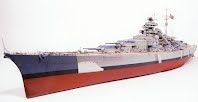 |
| C-Class | Scale: 1:96 Release: 2000 Limited Edition: 50 Model Size: 55”L x 10”W x 15”H Base Type: Black Walnut Base/Case Size: 61.5”L x 13.5”Wx 16”H C-Class Freighter As beautiful as the victory ships of late World War II were, many of them looked even better after the war when they were sold to private carriers. For more than thirty post-war years they sailed the world’s oceans as the ubiquitous C-class freighters. In 1941, the U.S. Maritime Commission undertook an emergency cargo shipbuilding program, from which more than 2,700 wartime Liberty ships were produced. Concurrently, the demands of forward planning required not only more ships, but faster and more sophisticated ones; thus came the Victory ships, the sequel to the Liberty ships, designed not only for immediate needs, but for service in the aftermath of war. These were designed to be fast ships, both as auxiliary vessels for the wartime fleet as well as commercial vessels. These wartime ship designs were designated as types C1 (up to 399 feet); C2 (400-449 feet) and C3 (450-499 feet), etc. The victory ships (with a V type prefix), at 455 ft. 3 in. overall, were type C3. Types of machinery were indicated by a separate code; e.g., S for steam and M for motor. Among the steam-powered ships, those with a 6,000shp turbine were designated AP2 for 16.3 knots and those with the 8,500shp were AP3s, good for up to 19 knots. Of the 534 victory ship hulls completed, 272 were of the VC2-S-AP2 type and 141 were of the VC2-S-AP3 type, while one was of the VC2-M-AP4 type (with diesel propulsion), 117 were of the VC2-S-AP5 type (transports), and three of the VC2-S1-AP7 type (entering service in 1947 as combined passenger-cargo ships). Beginning in August 1946, the Maritime Commission conducted a great sale of the new surplus of victory ships. Of the VC2-S-AP3s, 41 were transferred to US owners, including seven (7) to the States Steamship Company, seven (7) to Victory Carriers Inc., six (6) to the American President Lines, four (4) each to Moore-McCormack Lines, States Marine Corporation and Pope & Talbot Inc., three (3) to Pacific Far East Lines, two (2) to the American Export Line, and one (1) each to four (4) other companies. Thirty-three others were sold to foreign flag purchasers, four went to the US Army, and the remainder went to the National Defense Reserve Fleet, better known as the mothball fleet. These were laid up in eight different sites and then reactivated for such emergencies as the Korean War, the closing of the Suez Canal, Vietnam, or as special project ships for NASA research and missile or capsule recovery. Later they were scrapped as they became unsuitable for reactivation due to their advancing age. Fine Art Models As a companion to the SS Lane Victory, Fine Art Models built fifty (50) Victory Class cargo ships, as they appeared after the war, sailing for these private carriers. Our first model is of the ship completed as S.S. Brown Victory in March 1945 by the Oregon Shipbuilding Corporation’s yard at Portland. During her maiden voyage, while transporting supplies for US troops, a kamikaze hit her and she suffered extensive damage. Repaired, the Moore-McCormack Lines bought her in 1947 and for the next 23 years, she sailed as S.S. Mormacpine to South American and European ports. In 1970, after a final trip home from Uruguay, she again loaded a military cargo and sailed back across the Pacific one more time - this time for Saigon, and then on to Kaohsiung, Taiwan, where she was broken up. Our limited edition series includes the Moore-McCormack’s colorful Mormacpine, her sister Mormacfir, as well as Mormacelm and Mormacoak. |  |
| Chapman | Scale: 1:6 Release: 2003 Limited Edition: 5 Model Size: 30”L x 8”W x 29”H Base Type: Black Walnut Base/Case Size: 34”L x 12”Wx 31”H Our Swedish boyer yacht model is an edition of five (5) models built to world championship standards. It is a design of Fredrik Henrik Chapman, born in Gothenburg, Sweden September 9, 1721. To this day Chapman is considered one of the greatest shipbuilders ever to live. He is also the first known naval architect to use scientific principals in the design of his ships. Up until this time, a designer would build a builder’s model based on the experience of sailors, and then hand the model to the shipyard to be built (there were no plans as we know them today). Today, Chapman’s plans survive because of the book he published in Stockholm, Sweden more than two hundred years ago called “Architectura Navalis Mercatoria.” Proof of Chapman’s work is rendered not least by the fact that his “Architectura” ran into many editions and, combined with his “Tractat om Skepps-Byggeriet” (Treatise on Shipbuilding), completed several years later, has been translated into many languages all over the world. Chapman died August 19, 1808 at thee age of 87. The Chapman ship models we built are builder’s models with exposed bulkheads to show the method of construction. Furthermore, Chapman was a master of embellishment with his wonderful placement of carvings on his ships. The combination of the world-class carving on our ship models makes them part of that top 1% of all ship models, as it is far more than an exercise in patience and skill. It must be in the blood to reach to these levels and it is felt just by viewing the model - it is the same spirit and commitment felt when you look at a Chapman design. | 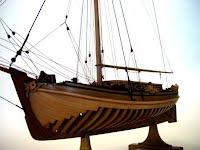 |
| Emden | Scale: 1:96 Release: 2005 Limited Edition: 50 Model Size: 49”L x 9”W x 19”H Base Type: Black Walnut Base/Case Size: 53”L x 11.5”Wx 21.5”H Named for the Ems River city, the light cruiser Emden was commissioned in 1910 and assigned to the East Asia Cruiser Squadron stationed at Tsingtao. In August 1913, Emden was part of a four-power fleet dispatched to protect U.S., British, German, and Japanese interests on the Yangtze River. As the European crisis approached in 1914, Captain Karl von Müller took Emden out of Tsingtao on July 31; World War I began the next day. In the Strait of Tsushima, Emden captured the Russian mail boat Rjasan on August 4, and returned to Tsingtao two days later. The East Asia Squadron then quit Tsingtao, and on August 12 Vice Admiral Maximilian Graf von Spee steamed east for home waters with Scharnhorst, Gneisenau, and Nürnberg. Emden and her supply vessel Markomannia threaded their way through the Dutch East Indies and into the Indian Ocean. In the shipping lanes between Burma and India, Emden began capturing Allied shipping, sometimes at the rate of two ships a day. On September 21, Emden stood about a half mile offshore and shelled the Burma Oil Company gas tanks in Madras. After a quick visit to Diego Garcia on October 9, where she narrowly missed an encounter with the armored cruiser HMS Hampshire and the armed merchant cruiser Empress of Britain, she resumed raiding. On October 21, Emden ran into Penang and torpedoed the Russian cruiser Yemtschuk; later that day she also sank the French destroyer Mousquet. Next von Müller decided to cut the transoceanic cable at the Cocos Keeling Island northwest of Australia. On November 9, a detachment of about 50 men under Hellmuth von Mücke landed at Direction Island. As they destroyed the radio shack, the radio operators informed them that the Kaiser had honored Emden's crew with Iron Crosses; the operators did not mention that they had reported the news of Emden's arrival. By this time, Emden had seized or sunk 16 merchant ships and was the object of a search by more than 75 Allied ships. At 0930, the arrival of the cruiser HMAS Sydney forced Emden to depart without the landing party. Emden opened fire at 0940 at a range of 5,600 yards. Sydney was able to keep out of Emden's range, and at about 1115 the helpless German cruiser was intentionally run aground on North Keeling Island. Emden's casualties included 141 dead and 65 wounded; Sydney suffered 4 dead and 12 wounded. Von Mücke and his landing party managed to steal the 97-ton copra schooner Ayesha and sailed to Pedang. From here they made their way to Istanbul. | 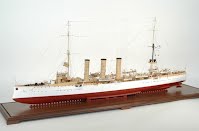 |
| Clipper | Scale: 1:50 Release: 1994 Limited Edition: 50 Model Size: 45”L x 19”W x 30”H Base Type: Black Walnut Base/Case Size: 48”L x 21”Wx 32”H Immediately following the outbreak of hostilities in 1812, British ships appeared to blockade the Atlantic and Gulf coasts of the United States. Baltimore shipbuilders stepped up their production of sharp-built schooners for use as blockade-runners and privateers. These schooners were designed for speed, and became more and more extreme. They were light, with sharply raked stem and sternpost, heavy with rigging, and like nothing else on the sea at that time. Speed was the advantage and, at the outset of the war, many of the schooners were equipped with sails of a new cotton duck rather than flax. The cotton sails held their shape better, were lighter and required less wetting down, which caused the fabric to swell, close the weave, and thereby hold the wind better. They were also whiter than flax and, along with the rake of the schooner’s mast and cut and number of sails, contributed to the speed and distinctive profile of what was to be called the Baltimore Clipper. The Lynx was one of the most fully documented Baltimore Clippers. The 94-foot Lynx was a vessel of 225 tons, had a crew of 35, and mounted six 12-pounder guns while carrying a cargo of cotton, coffee and sugar. She was built in 1812 for James and Amos Williams and Levi Hollingsworth, and was commissioned on July 14, 1812. This beautiful vessel was an example of the highest development of the Baltimore Clipper | 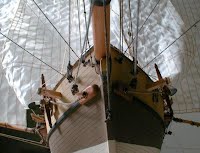 |
| Endurance | Scale: 1:48 Release: 2002 Limited Edition: 50 Model Size: 46”L x 12.5”W x 26”H Base Type: Black Walnut Base/Case Size: 50”L x 16.5”Wx 28”H Availability: 1 Available Shackleton. His very name evokes images of hardship and survival under the most desperate circumstances, as does the name of his ship—derived from his family’s motto, “Fortitudine Vincimus” - “by endurance we conquer,” the Endurance. In 1901, Captain Robert Falcon Scott undertook the first attempt to reach the South Pole in the Discovery, launching the heroic age of polar exploration. First to actually reach the pole were four (4) Norwegians, led by Roald Amundsen, on December 14, 1911 (Scott and four (4) companions also reached it about a month later, only to die from exposure and hunger during their return). By 1914, 40-year-old Sir Ernest Shackleton had already participated in Scott’s first polar expedition as well as one other, and understood the extreme hardships involved. Amundsen’s accomplishment notwithstanding, he recruited men and support for a new Imperial Trans-Antarctic Expedition, intent on crossing the continent on foot. He chose the 300-ton 144-ft. wood hull barkentine Polaris, built at Norway’s Framnaes shipyard, whose extreme-strength ships were favored for polar exploration. The Endurance, as he renamed her, was built of oak and fir up to 2 ½ feet thick and sheathed in greenheart—a wood so tough that special methods were needed to work it. Sailing south as World War I broke out in August 1914, the Endurance became icebound just short of the Antarctic coast, then frozen fast as the ice became tightly packed by several days of high winds from the northeast. Immobilized for ten months, the crew abandoned her as she was crushed and finally lost on October 27, 1915. Stranded on the ice, Shackleton and his crew of 28 made their way with their lifeboats to barren Elephant Island, which offered no shelter, food, nor the prospect of rescue. On April 24, 1916, Shackleton chose five (5) crewmen and embarked in the 22 ½ foot James Caird on one of history’s most fantastic voyages: despite being able to take only four (4) star sightings, they traveled 800 miles over 17 days through seas up to 70 feet and “miraculously,” in their own words, reached their objective, South Georgia Island. Still 150 sea miles short of the whaling station in Stromness Bay on the other side of the mountainous island, with only rags for clothing, Shackleton and two (2) of his men struck out again—this time trekking 22 miles over uncharted alpine terrain—and, to the absolute astonishment of those present, stumbled into the whaling station 36 hours later. The three (3) men back at the landing were promptly rescued, but not until August 30, 1916, three months and three aborted attempts later, did the trawler Yelcho finally retrieve the remaining crew members from Elephant Island. Amazingly, Shackleton lost no men on this 22-month odyssey, the last expedition of the heroic age and while he set out again for Antarctica with several Endurance shipmates in 1921, he died of a heart attack the following January. He is buried on South Georgia Island, and is considered one of the most respected explorers of all time. About the Model… Many books and films have been produced about Shackleton’s expedition, but no one had ever modeled the ship before. Until now. One of Fine Art Models’ contacts was able to locate her plans, which had been put in storage after the Framnaes shipyard went out of business. The result, as you see here, is one of the most interesting scale models built to date. Fine Art Models has built this limited edition, Endurance ship model in a scale of 1:48 with exacting detail. Each Endurance model is built by a team of eight (8) of the most skilled craftsmen in the world with more than 500 man hours just to assemble. Computers were used to generate exact scale drawings from the original plans and picture reference of the ship in Antarctica. All of the materials used to construct the ship meet and/or exceed museum quality standards including a space age, high definition hull, genuine wood deck, masts and yards with additional fabricated wood and brass features. In addition, all of the paint used is custom-made and impervious to ultra-violet light. As with all Fine Art Models, the Endurance scale model comes complete with a Black Walnut base and leaded glass display case. | 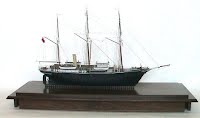 |
| Essex Class | Essex-Class Carrier - Yorktown Scale: 1:192 Release: 1998 Limited Edition: 25 Model Size: 58”L x 11”W x 12”H Base Type: Black Walnut Base/Case Size: 62”L x 14”Wx 14”H Essex-Class Carrier - Intrepid Scale: 1:192 Release: 1998 Limited Edition: 25 Model Size: 58”L x 11”W x 12”H Base Type: Black Walnut Base/Case Size: 62”L x 14”Wx 14”H Essex-Class Carrier - Intrepid Camouflage This is one of the most difficult camouflage schemes to execute and we feel we have achieved our goal, to perfection. We are producing only one per year. Scale: 1:192 Release: 1998 Limited Edition: 10 Model Size: 58”L x 11”W x 12”H Base Type: Black Walnut Base/Case Size: 62”L x 14”Wx 14”H “The ships that won the war” were the fleet aircraft carriers of the Essex class. At 24 units, the largest class of capital ships built during the 20th century, the Essex-class carriers were some of the most successful. In warfare, the deployment of a decisive technology can determine the outcome. In the Pacific theatre of World War II, the decisive technology was the carrier-borne airplane. The Japanese demonstrated its possibilities in their attack on Pearl Harbor. And the Battle of the Coral Sea was the first naval battle in history in which ships of the opposing sides never came into sight of one another. In June 1942, US carrier-borne aircraft unexpectedly sank four (4) Japanese carriers on a single day at the Battle of Midway. The United States took the offensive thereafter, with an ever-increasing number of new aircraft carriers as the centerpieces of its effort to bring war to the Japanese homeland. At more than 800 ft. in overall length, fleet carriers (CVs) were the largest of these. Eleven (11) ships, of the design that became the Essex class, were authorized in 1940. By the war’s end, seventeen (17) new fleet carriers had been commissioned, all of them Essex class ships, and seven (7) more sisters were completed after the war. Their design was excellent - effective, reliable and versatile. Their mass production reflected both the enormous industrial capacity of the United States and standardization and simplification of production methods. One ship, USS Franklin, was completed in just under fourteen (14) months. As built, they displaced more than 27,000 tons (more than 36,000 tons fully loaded) and, at 150,000 shp, they could exceed 32 knots on trial. Their range was also outstanding: 20,000 nautical miles at 15 knots. Normal complement, including air groups, was about 3,200 officers and men. They were virtually without armor - designers expected their regular complement of 90 aircraft to provide for both offense and defense. This paid off during the air battle for Saipan, when their aircraft shot down nearly 400 Japanese planes in one day. Although some suffered severely when hit later during suicide attacks, none were lost. After the war, their flight decks were strengthened to handle jet aircraft and angled to speed operations, recover damaged aircraft, and provide for round-the-clock capability. Thus modernized, many served even into the seventies, e.g., as recovery ships for the space program. Four (4) have been preserved and are now open to the public USS Yorktown (CV 10) in Charleston, USS Intrepid (CV 11) in New York, USS Hornet (CV 12) in Alemeda, California and USS Lexington (CV 16) in Corpus Christi Fine Art Models Fine Art Models spent more than two (2) years researching the Essex class carrier. There were two (2) versions during World War II, ten (10) with short hulls and the remainder with long hulls, which had extended bows but a shorter flight deck (to provide the forward anti-aircraft guns with a wider arc of fire). After building a short-hull prototype from official US Navy plans for the Intrepid, we understand why there has never been such a carrier model offered by anyone prior to this. These ship models are as complex in design as any we know of - from tie-down hooks on the decks, to under-deck detail, to ship-specific radar suites. We started our production with Yorktown (CV 10) and Intrepid (CV 11), and will continue with other short-bow units including Essex (CV 9), Hornet (CV 12), Lexington (CV 16), and Wasp (CV 18). Later we will add long-bow units including Ticonderoga (CV 14), Randolph (CV 15), Hancock (CV 19), and Princeton (CV 37). Eventually, we will include all ships of the class in our limited edition, but look forward to satisfying the preferences of those who order early. Each model comes with 1:192 aircraft, including the Corsair, Avenger, Helldiver and Hellcat. The detail on the planes includes cockpit interiors, antennae made with a human hair and complete underbody detail including wheel wells. Additional airplanes are available as an option to anyone ordering an Essex. | 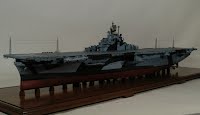 |
| Fitzgerald | Scale: 1:144 Release: 1995 Limited Edition: 50 Model Size: 61”L x 6.5”W x 11”H Base Type: Black Walnut Base/Case Size: 65”L x 9”Wx 12”H The official number of the Edmund Fitzgerald was 277,437, and she was built in 1958 as hull No. 301 by the Great Lakes Engineering works at River Rouge, Michigan. On June 8, 1958, she was christened by, the wife of the president of Northwestern Mutual Life Insurance Company, Mrs. Edmund Fitzgerald. With an overall length of 729 feet and gross tonnage of 13,632, she became the largest ore carrier on the Great Lakes and would remain so until 1971. Although owned by the Northwestern Mutual Life Insurance Company of Milwaukee, the Fitzgerald was under charter to Columbia Transportation Division of the Oglebay Norton Company of Cleveland, Ohio. She set numerous shipping records, including hauling 1.2 million gross tons of ore through the Soo Locks. Her single trip record load was 27,402 gross tons. November has traditionally been the worst time of year for storms on the Great Lakes. The notorious storm of November 1913 sank 12 vessels, blew 16 more aground, and resulted in the loss of 254 sailors. Again in November 1940, another storm sank five (5) vessels and claimed 67 men. November 10, 1975 was also cruel, and this time it claimed the Edmund Fitzgerald, her captain and crew of 28 men. The Fitzgerald disappeared from the radar screen of the trailing Arthur M. Anderson ore carrier without so much as a distress call. The sinking of such an enormous ship caused considerable stir and controversy because 729 foot steamers don’t just disappear. And when it happened, it was national news. Gordon Lightfoot made it to No. 1 on the popular music charts with a ballad entitled “The Wreck of the Edmund Fitzgerald.” Fine Art Models We worked for more than two (2) years researching every aspect of this great ship and amassed an impressive archive of material with which to build this model, from all her original plans to plans used in her update. We have actual paint samples for every color used on her from the original paint supplier. Perhaps most important of all, we obtained rare photographs of the Fitzgerald the day before that fateful 1975 storm. The hull of our model is made of high-definition resin with every boiler plate line and rivet defined. From the deck up, the superstructure is made of fabricated and photo-etched brass. No detail has been overlooked. No compromise has been made. Our model is our tribute, not only to the captain and crew of the Fitzgerald, but to every other ship and crew claimed by the Great Lakes. |  |






